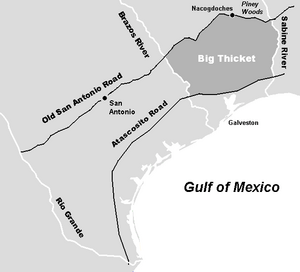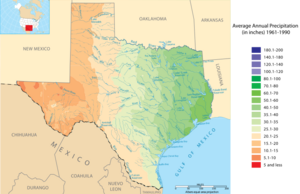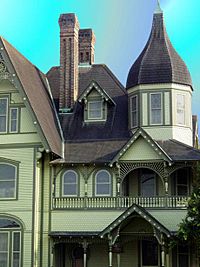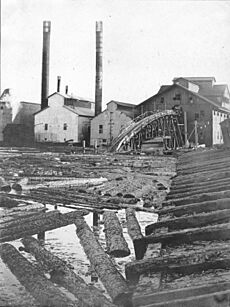History of Texas forests facts for kids

The forests in the U.S. state of Texas have been a super important natural resource for a long time. These huge woodlands, once home to lots of different animals, helped early settlers make a living. Today, they are still very important for Texas's economy and environment.
The thickest forests are in eastern Texas, in a place called the Piney Woods. The Big Thicket area, near Houston and Beaumont, used to have the densest trees. For a long time, not many people lived in the Big Thicket. It was even a safe place for people seeking freedom and others hiding from the law. When Spanish explorers first arrived, the Rio Grande Valley in South Texas had a huge forest of palm trees, but sadly, most of it is gone now.
One of the first sawmills in Texas that used steam power was planned in 1829 in what is now Houston. After the Texas Revolution, more and more wood was needed. By 1860, there were about 200 sawmills in the state! When railroads were built across eastern Texas in the 1880s, lumber production really took off. The next 50 years, when the Texas timber industry was booming, became known as the "bonanza era." This growth brought a lot of money to Texas. However, there weren't many rules, so some business owners took advantage of people. They sometimes took private land and made workers accept bad conditions and low pay.
By the early 1900s, timber was one of the biggest money-makers in Texas. It was the state's largest manufacturing business. Rich lumber owners, like John Henry Kirby, were among the wealthiest people in Texas. By 1907, Texas was the third largest lumber producer in the United States. Later, forests were cleared for oil drilling and to meet the demand for wood. This destroyed much of the remaining forest land in the state. By the 1920s, lumber production was slowing down. The Great Depression then hit the industry very hard.
In more recent times, people have worked to protect the forests. For example, the Texas Big Thicket National Preserve was created in 1974. These efforts have helped keep parts of the Texas woodlands safe. Even today, Texas is still one of the top ten timber-producing states in the United States.
Contents
Texas's Changing Landscapes
The weather in Texas is very different from one part of the state to another. Humid, rainy swamps are in the east, while dry desert lands are in the far west. In between, you can find woodlands, grasslands, and brushlands. A key weather feature in Texas is a dry line that runs north-south through the middle of the state. East of this line, moist air from the Gulf of Mexico flows freely. West of it, drier air from the Mexican deserts takes over. Most of the forests are east of this line, but some small wooded areas can be found in the mountains to the west.
Texas sometimes has very bad droughts that can last for several years, even up to ten years. The worst one in modern history was the 1950s Texas drought. These dry periods can greatly shrink the forests. For example, a severe drought in 2011 is thought to have killed between two and ten percent of the state's trees.
Texas forests can be divided into six main areas:
- The Big Thicket
- The Piney Woods
- The Gulf Coast
- The Edwards Plateau
- The lower Rio Grande Valley
- The Trans-Pecos mountain forests
East Texas is home to the Piney Woods. This huge region stretches from Texas into parts of Oklahoma, Arkansas, and Louisiana. These woodlands have many types of pine trees. They also have hardwood trees like magnolia, American Sweetgum (Liquidambar styraciflua), and elms (Ulmus species). The Big Thicket is the southern part of this region. It has historically been the most densely wooded part of Texas. It acted like a natural barrier between Southeast Texas and coastal Louisiana.
The Texas coastal region has fewer trees, but still many types. These include Southern Live Oak (Quercus virginiana), mesquite (Prosopis species), and Texas Persimmon (Diospyros texana). The Edwards Plateau region in Central Texas has woodlands with Ashe Juniper (Juniperus ashei), Texas Live Oak (Quercus fusiformis), and Honey Mesquite (Prosopis glandulosa). The lower Rio Grande Valley used to have a large semi-tropical forest of Mexican Palmetto (Sabal mexicana).
Even though West Texas is mostly grasslands and desert, mountainous areas in the Trans-Pecos part, like the Guadalupe Mountains, have small forest areas. These forests feature Bigtooth Maple (Acer grandidentatum), Velvet Ash (Fraxinus velutina), Grey Oak (Quercus grisea), and similar tree species.
Other smaller forest areas include the Cross Timbers in North Texas, near the Dallas – Fort Worth metroplex. There's also the Lost Pines Forest in Central Texas. These are found in the savanna and blackland prairies west of the Piney Woods and coastal areas. The Cross Timbers region, which crosses Texas and Oklahoma, was once so thick it was considered a natural barrier. While these woodlands were never a major source of lumber, they provided firewood and wood for poles and railroad building. Some original oak and hickory woodlands still exist in eastern Texas ranchlands, west of the Piney Woods. These are known as the East Central Texas forests ecoregion.
Early Texas Forests and the Republic

The Big Thicket forest region once covered more than 2 million acres in East Texas. The Spanish, who ruled the area, described its borders. To the north was El Camino Real de los Tejas / Old San Antonio Road. To the south was La Bahia Road. To the west was the Brazos River, and to the east was the Sabine River. This very thick forest was a natural barrier, making it hard for people to settle there. It remained mostly empty, even by Native Americans, until the 1800s.
In the Rio Grande Valley, a large forest of Mexican Palmetto (Sabal mexicana) stretched from the coast about 80 miles inland as late as 1852. Spanish explorer Alonzo Alvarez de Pineda even named the river Río de las Palmas (Palm River) in 1519 because of the forest around it.
When Europeans first arrived in East Texas, the Hasinai, Bidai, and Akokisa tribes lived near the edges of the Big Thicket. These tribes mostly farmed. They avoided settling deep in the forests because the sandy soil there was not as good for growing crops as the clay-rich soils outside the dense forests.
In the early 1800s, as more settlers moved west in North America, the forests of East Texas became a popular hiding place for people seeking freedom and others running from the law in the United States.
One of the first steam-powered sawmills in Texas was planned in 1829 by John Richardson Harris. He was the founder of Harrisburg (now part of Houston). This sawmill operated until at least 1833. After the Texas Revolution, many new settlers arrived, and the demand for wood quickly grew. Sawmills were built along the coast in places like Galveston, Houston, and Beaumont. As people moved further inland, new mills were built in towns from Nacogdoches to Bastrop.
The Lost Pines Forest near Bastrop, which is the westernmost group of pine trees in Texas, became an important source of wood for Central Texas.
Texas in the 1800s: The Lumber Boom
After Texas joined the United States, the timber industry continued to grow. By 1860, there were about 200 sawmills in the state. The value of wood products was over $1.75 million each year.
In Central Texas, the forests were used up much faster than in the East. By the mid-1800s, oak wood became so rare in many areas that stone and brick building started to replace wood in many communities.
Even in 1870, the main forests of East Texas were still mostly untouched. Some trees grew to more than 150 feet tall and over 5 feet wide! This changed quickly in the 1880s when railroad lines were finished across the state. In 1877, two businessmen from Pennsylvania, Henry J. Lutcher and G. Bedell Moore, opened a huge mill in Orange. It was the largest and most modern operation in Texas.
The timber industry then entered what was called the "bonanza era." Lumber factories and logging roads spread throughout the forests. Mill owners built company towns, like Camden, Kirbyville, and Diboll, to attract workers. Working conditions for timber workers were tough and dangerous. Workdays were usually 11 hours long, and pay was typically between $1.50 to $2.50 per day. In many cases, the owners had almost complete control over these towns and the people who lived there.
In the late 1800s, a new machine called a skidder was used in Texas logging. A skidder was a railway car with a crane and long cables. It dragged cut logs out of the forest. This dragging process was very damaging to the forests. It cleared trees much faster, both because it was efficient at moving logs and because it accidentally harmed other plants.
A big problem with the growth of the lumber industry was that land was taken from families who had owned it. Because of certain laws in Texas at that time, rich lumber owners, with money from investors, could take land that belonged to local families. Often, these families had owned the property for many generations.
An East Texas farmer named John Henry Kirby slowly bought many mills. In 1901, he combined them to form the Kirby Lumber Company. This was the largest lumber company in Texas at the start of the 1900s. Kirby was even called the "Prince of Pines" by newspapers in Texas.
Oil Boom and World Wars
| Year | Annual production |
|---|---|
| 1869 | 100 million board feet |
| 1879 | 300 million board feet |
| 1907 | 2.25 billion board feet |
| 1932 | 350 million board feet |
| 1940 | 1 billion board feet |
| 1991 | 1.134 billion board feet |
| 1992 | 1.25 billion board feet |
| 1997 | 1.37 billion board feet |
By the early 1900s, farming (especially cotton), timber, and ranching were the main ways Texas made money. Lumber production became the biggest manufacturing business in the state. The industry kept growing in the early years of the century. Production grew from 300 million board feet each year in 1879 to 2.25 billion board feet in 1907. This was the most wood Texas has ever produced. Texas became the third largest lumber-producing state in the U.S. World War I made the demand for wood even higher, as ships made of pine were common then.
The early 1900s also saw large lumber companies from outside Texas move into the state. Long-Bell Lumber Company, a company from Kansas, opened a branch in Lufkin, Texas in 1905. Other outside companies also came. Many of them followed a "cut-out-and-get-out" policy. This meant they harvested all the available trees in an area and then left it completely. Even at the start of the 1900s, it was clear that the Piney Woods were being cut down too fast. In 1904, a U.S. forester said that, if logging continued this way, the original forests might not last more than two decades.
In 1901, the Gladys City Oil, Gas, and Manufacturing Company found oil at Spindletop Hill, near Beaumont, Texas. While oil had been found in Texas before, Spindletop was by far the most productive oil well in world history. This event started a period of amazing economic growth for the state. The clearing of land for oil drilling and the high demand for wood through the first half of the 1900s destroyed much of the remaining forest lands in Texas.
By the end of World War I, the demand for timber was going down. The Texas timber industry had actually reached its peak in 1907–1908. By the 1920s, Texas's forests were severely depleted, and most of the original pine trees had been cut. The lumber industry slowed a lot as companies, whose lands were mostly out of timber, reduced or stopped their operations. Long-Bell and other lumber companies left Texas and moved to the Pacific coast and other parts of the country. By 1932, during the Great Depression, wood production in Texas had fallen to 350 million board feet. The 50-year "bonanza era" had ended, with about 18 million acres of forest having been cut down by lumber companies.
In the south, more people moving to and developing the Rio Grande Valley led to the palm tree forests being cleared for farming. By the 1930s, the once vast forests in the valley had shrunk to small areas around Brownsville.
Efforts to save what was left of the forests began. The East Texas Big Thicket Association was formed in the 1920s to protect the small remaining parts of the Big Thicket. While this group didn't have a huge impact, it showed that people were becoming more worried about the woodlands. In 1924, the state forester, E. O. Siecke, successfully created the first state forest in Texas (named E. O. Siecke State Forest in 1951). This forest covered about 1,702 acres near Kirbyville. By 1925, more state forest lands were bought in Cherokee and Montgomery Counties.
In 1930, the Angelina County Lumber Company planted 200,000 pine seedlings. This was one of the first big efforts to replant trees in the state. In 1933, the Texas legislature allowed the purchase of specific lands for the National Forest system. This created Angelina, Davy Crockett, Sam Houston, and Sabine National Forests. These lands were mostly areas that had been cut down and cleared by lumber companies. The United States Forest Service and the Texas Forest Service began working to re-establish forests on these and other properties around the state.
Texas Forests Today
In 1944, a tree farm program started in Texas, following a model from Alabama. With support from various groups, including the Texas Forest Service, this program set up training and rules. These rules encourage ways of harvesting trees that can be continued over time and protect local wildlife and nature.
The timber industry in Texas slowly started to grow again in the mid-1900s. New technologies, like machines that remove bark from logs and pine-based plywood, made it possible to use more of each tree. This made trees more valuable. By 1982, lumber producers were among the top manufacturing businesses in the state.
In 1974, the Texas Big Thicket National Preserve, covering about 84,550 acres, was created by the U.S. Congress. This preserve actually has 12 separate areas of forest land that are protected from logging. These and other efforts to preserve forests have helped stabilize parts of the Texas woodlands.
Tree farm certifications steadily increased in the mid-1900s. By 1984, there were 2,510 certified, privately owned farms in Texas. These farms covered more than 4 million acres of timberland, mostly in East Texas.
In 1994, the national forests in Texas alone produced 93.8 million board feet of timber. This brought in over $73 million and created 2,098 jobs. In 1992, timber companies in the state produced more than 1.25 billion board feet, and in 1997, they produced over 1.37 billion board feet. As of 1999, Texas was the tenth largest timber-producing state in the nation. The main wood product is Southern yellow pine, which mostly supplies the housing industry in the state. Cities like Nacogdoches, Lufkin, Beaumont, and Marshall still have large lumber companies that are a big part of their economies.
As of 2010, the World Wide Fund for Nature considers the Piney Woods region to be one of the most endangered natural areas in the United States.
Important People in Texas Forests
Lumber Leaders
| Company | Founder(s) | Founded |
|---|---|---|
| Lutcher-Moore Lumber Company |
Henry J. Lutcher, G. Bedell Moore |
1842 |
| W.T. Carter and Brother Company |
W. T. Carter | 1897 |
| Angelina County Lumber Company |
Joseph H. Kurth | 1890 |
| Southern Pine Lumber Company / Temple Industries |
Thomas L. L. Temple | 1893 |
| Kirby Lumber Corporation |
John H. Kirby | 1901 |
| Frost-Johnson Lumber Company |
Enoch Wesley Frost | 1902 |
Henry J. Lutcher and G. Bedell Moore came to Orange, Texas, in 1877 to join the new Texas lumber industry. They set up the first large-scale milling operation in the state. They also brought in advanced technology and set high quality standards that the lumber industry would follow. Businessmen like Joseph H. Kurth, Thomas L. L. Temple, and W. T. Carter built powerful lumber companies that controlled huge areas of the state.
John H. Kirby is seen by some as the first of the great lumber leaders of Texas. He is also considered the state's first major industrialist. Kirby started as a country lawyer in East Texas. In the 1880s, he gathered investors to buy timber land in Texas and start many lumber operations. In 1901, he took full control of all these operations, forming the Kirby Lumber Company. It was the largest in the state and possibly the largest in the southern United States. Kirby once controlled the largest area of pine trees in the world.
Some lumber leaders, including Kirby, changed their focus to oil as the lumber boom ended and the oil boom began in the 1920s and 1930s.
Forest Protectors
In 1889, the U.S. Bureau of Forestry chief, B. E. Fernow, asked W. Goodrich Jones, a banker from Temple, Texas, to survey the East Texas forests. Jones knew about forestry from his youth in the Black Forest of Germany. He later started the Texas Forest Association in 1914. He worked with local lumber companies and the state government, which led to the creation of the Texas Forest Service in 1915. Jones became known as the Father of Forestry in Texas.
In 1927, R. E. Jackson, a railroad conductor who regularly traveled through the East Texas forests, formed the East Texas Big Thicket Association. The group's main goal was to protect 400,000 acres of the forest and save it from being destroyed. The group struggled because it didn't have enough money. Also, the high demand for resources during World War II greatly reduced its influence.
See also
- List of Texas state forests
- Logging
- Texas Forest Service
- Texas Parks and Wildlife Department





